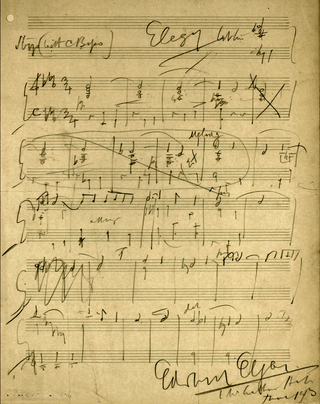Related Research Articles

Sir Edward William Elgar, 1st Baronet, was an English composer, many of whose works have entered the British and international classical concert repertoire. Among his best-known compositions are orchestral works including the Enigma Variations, the Pomp and Circumstance Marches, concertos for violin and cello, and two symphonies. He also composed choral works, including The Dream of Gerontius, chamber music and songs. He was appointed Master of the King's Musick in 1924.
Events in the year 1899 in music.

Frederick William Gaisberg was an American musician, recording engineer and one of the earliest classical music producers for the gramophone. He himself did not use the term 'producer', and was not an impresario like his protégé Walter Legge of EMI or an innovator like John Culshaw of Decca. Gaisberg concentrated on talent-scouting and persuading performers to make recordings for the newly invented Gramophone.

Edward Elgar's Cello Concerto in E minor, Op. 85, his last major completed work, is a cornerstone of the solo cello repertoire. Elgar composed it in the aftermath of the First World War, when his music had already become out of fashion with the concert-going public. In contrast with Elgar's earlier Violin Concerto, which is lyrical and passionate, the Cello Concerto is for the most part contemplative and elegiac.

The Dream of Gerontius, Op. 38, is a work for voices and orchestra in two parts composed by Edward Elgar in 1900, to text from the poem by John Henry Newman. It relates the journey of a pious man's soul from his deathbed to his judgment before God and settling into Purgatory. Elgar disapproved of the use of the term "oratorio" for the work, though his wishes are not always followed. The piece is widely regarded as Elgar's finest choral work, and some consider it his masterpiece.

Edward Elgar's Violin Concerto in B minor, Op. 61, is one of his longest orchestral compositions, and the last of his works to gain immediate popular success.

In the South (Alassio), Op. 50, is a concert overture composed by Edward Elgar during a family holiday in Italy in the winter of 1903 to 1904. He was working on a symphony, but the local atmosphere inspired him instead to write what some have seen as a tone poem, with an Italian flavour. At about 20 minutes' duration it was the composer's longest sustained orchestral piece to that time.

Falstaff – Symphonic Study in C minor, Op. 68, is an orchestral work by the English composer Edward Elgar. Though not so designated by the composer, it is a symphonic poem in the tradition of Franz Liszt and Richard Strauss. It portrays Sir John Falstaff, the "fat knight" of William Shakespeare's Henry IV Parts 1 and 2.

The Wand of Youth Suites No. 1 and No. 2 are works for orchestra by Edward Elgar, first performed in 1907 and 1908 respectively. The titles Elgar gave them were, in full: The Wand of Youth First Suite, Op. 1a (1869–1907) and The Wand of Youth Second Suite,. The music was drawn from material written by the composer in his youth and orchestrated forty years or so later.

The Sonata in G major, Op. 28 is Edward Elgar's only sonata composed for the organ and was first performed on 8 July 1895. It also exists in arrangements for full orchestra made after Elgar's death.

The Nursery Suite is one of the last compositions by Edward Elgar. Like Elgar's The Wand of Youth suites, it makes use of sketches from the composer's childhood.

"The Wind at Dawn" is a poem written by Caroline Alice Roberts, and set to music by the English composer Edward Elgar in 1888.
”Through the Long Days” is a song written by the English composer Edward Elgar in 1885 as No. 2 of his Op. 16, Three Songs. The words are from a poem by the American writer and statesman John Hay.

"After" is a song written by the English composer Edward Elgar in 1895, as his Op. 31, No. 1, with the words from a poem by Philip Bourke Marston.

The Fringes of the Fleet is a booklet written in 1915 by Rudyard Kipling (1865–1936). The booklet contains essays and poems about nautical subjects in World War I.
Salut d'Amour (Liebesgruß), Op. 12, is a musical work composed by Edward Elgar in 1888, originally written for violin and piano.
Lawrance Arthur Collingwood CBE was an English conductor, composer and record producer.
The first recording of Edward Elgar's Symphony No 1 was made by the London Symphony Orchestra in 1930, conducted by the composer for His Master's Voice. The recording was reissued on long-playing record (LP) in 1970, and on compact disc in 1992 as part of EMI's "Elgar Edition" of all the composer's electrical recordings of his works.
Edward Elgar's Symphony No 2 was first recorded complete in 1927 by His Master's Voice conducted by the composer. This recording was reissued on LP record and later on compact disc. There was no further recording for seventeen years, until Sir Adrian Boult made the first of his five recordings of the symphony in 1944. Since then there have been many more new recordings, the majority played by British orchestras with seven of them recorded by the London Philharmonic.

Elegy, Op. 58 is a short piece for string orchestra by Edward Elgar, composed in 1909. It was written in response to a request for a short piece to commemorate deceased members of the Worshipful Company of Musicians. The work was composed within a month of the death of his close friend August Jaeger and may reflect Elgar's grief at his loss.